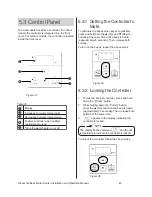
Rinnai Tankless Water Heater Installation and Operation Manual
33
4.7 Install Pressure Relief Valve
Water discharged from the pressure relief valve could cause severe burns
instantly or death from scalds.
4.7.1 Guidelines
An approved pressure relief valve is required
by the American National Standard (ANSI
Z21.10.3) for all water heating systems and shall
be accessible for servicing. When connecting
a pressure relief valve, follow the guidelines
below:
•
The pressure relief valve must comply
with the standard for Relief Valves and
Automatic Gas Shutoff Devices for Hot
Water Supply Systems ANSI Z21.22 and
/or the standard Temperature, Pressure,
Temperature and Pressure Relief Valves
and Vacuum Relief Valves, CAN1-4.4.
•
The pressure relief valve must be rated
up to 150 psi and to at least the maxi
-
mum Btu/hr of the appliance.
•
The discharge from the pressure relief
valve should be piped to the ground or
into a drain system per local codes.
•
The pressure relief valve must be
manually operated once a year to check
for correct operation.
•
The discharge line from the pressure
relief valve should pitch downward and
terminate 6 in. (152 mm) above drains
where discharge will be clearly visible.
•
The discharge end of the line shall be
plain (unthreaded) and a minimum of 3/4
in. nominal pipe diameter. The discharge
line material must be suitable for water
at least 180°F.
•
The pressure relief valve is connected
below the appliance. DO NOT place any
other valve or shut off device between
the pressure relief valve and the water
heater.
•
If a pressure relief valve discharges
periodically, this may be due to thermal
expansion in a closed water supply sys
-
tem. Contact the water supplier or local
plumbing inspector on how to correct
this situation. DO NOT
plug the pressure
relief valve.
•
The American National Standard (ANSI
Z21.10.3) does not require a combination
temperature and pressure relief valve for this
appliance. However, local codes may require
a combination temperature and pressure
relief valve.
•
Protect pressure relief valve and pressure
relief valve discharge line from freezing. Do
not plug or restrict flow of the pressure relief
valve.
•
DO NOT plumb the pressure relief valve with
the condensate drain; both must be plumbed
independently to drain.
•
DO NOT plug the pressure relief valve and
do not install any reducing fittings or other
restrictions in the relief line. The pressure
relief line should allow for complete drainage
of the valve and the line.
•
DO NOT place any other valve or shutoff
device between the pressure relief valve and
the water heater.
Pressure Relief Valve Maintenance:
For proper care of this approved pressure relief
valve, it is recommended that the valve is manually
operated once a year. In doing so, it will be
necessary to take precautions with regard to the
discharge of potentially scalding hot water under
pressure. Ensure discharge water has a safe place
to flow. Contact with your body or other property
may cause damage or harm.
WARNING
















































